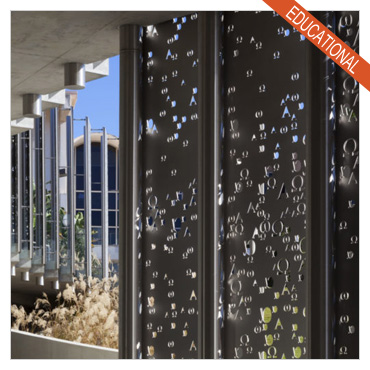|
|
|
FORM + FUNCTION |
 |
Point Loma Nazarene University (PLNU), an evangelical university in San Diego, opened its science center in 2015. Designed by Carrier Johnson + CULTURE, the Sator Science Center houses the acclaimed science department as well as reflecting the university’s focus on faith. The two-story, 3344-m2 (36,000-sf) facility features up-to-date technology, laboratories, and classrooms to support collaborative research and various science majors. Specifically, it includes four classrooms and 13 laboratories intended for biology, chemistry, and anatomy. It is connected to the previously existing Rohr Science Building via an elevated walkway with a patio overlooking the Pacific Ocean. An outdoor classroom is located between the two centers.
|
|
|
LAW
Arbitration is an important topic in construction. Standard-form contracts used in the construction industry, such as the American Institute of Architects (AIA) documents, specifically reference the possible use of arbitration, although the parties may have to check a box on a form to make this the final dispute resolution process. Every year, several reported construction cases revolve around arbitration issues. This article examines a few recent cases, discussing situations where one party claimed it was not required to arbitrate.
|
|
EVENTS
January 28-February 1
ASHRAE Conference/AHR Expo
American Society of Heating, Refrigerating, and Air-conditioning Engineers
Las Vegas, Nevada
www.ashrae.org
January 29-February 2
Sprayfoam 2017 Convention & Expo
Spray Polyurethane Foam Alliance (SPFA)
Palm Springs, California
www.sprayfoam.org/expo
February 12-15
AAMA 80th Annual Conference
American Architectural Manufacturers Association
Phoenix, Arizona
www.aamanet.org/events
March 16-21
RCI International Convention and Trade Show
RCI
Anaheim, California
rci-online.org
April 4-7
Coverings
Tile of Spain/Ceramics of Italy/TCNA
Orlando, Florida
www.coverings.com
|
|
|
VIEW LATEST ISSUE

|
|
TOP TRENDING ARTICLES |
Tilt-up concrete construction was identified as an efficient and effective method for raising a complex concrete façade without the tedious vertical forming process. Its pioneers capitalized on a method of erecting modern concrete façades with even greater efficiencies. Wartime economies, however, tipped the scale in favor of tilt-up construction’s ease of use, speed of erection, and low cost. By mid-century, it had come to be used almost exclusively for low-cost housing and big-box buildings—its reputation as a ‘warehouse’ material became entrenched. But if you still think of tilt-up as more utilitarian than beautiful, get ready to be surprised.
|
One of Baltimore’s most visible and recognizable buildings is located at 10 Light Street, close to the waterfront. The 34-story structure is considered to be the first skyscraper in the city; it has remained its tallest building for nearly 50 years. The construction of the tower started in July 1928 and was completed in 15 months. This is a remarkable feat given its magnitude—approximately 46,450 m2 (500,000 sf),the structure stands taller than 152 m (500 ft). While the designer, Taylor & Fisher-Smith & May, and the builder, J. Henry Miller, created the iconic tower to last forever, age and natural elements necessitated efforts to reinforce and renew the exterior features…
 READ MORE READ MORE
|
Major flooding has dominated international news in recent years. While it may not be occurring more frequently than it was 50 years ago, due to growing infrastructure, the impact is certainly greater. Since 1949, the U.S. population has doubled, leading to a rapid increase in the construction of the urban environment. Most cities are unprepared for these rare increases in water levels—initiatives to protect infrastructure from major damage too often occur only after the destruction. Concrete walls naturally protect against structural damage that can be caused by the effects of nature. Many century-old structures stand longer than those erected in the last 50 years. This is largely due to reinforcement methods—instead of using solid stone, most U.S. infrastructure contains reinforcing steel embedded within poured concrete.
|
|
|
|
|
|

